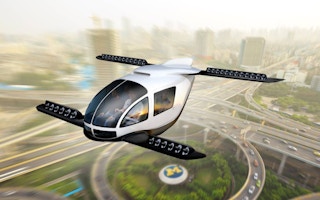Futuristic electric flying taxis like those seen in the movie “Blade Runner” could offer a more sustainable - and much faster - way to travel long distances than traditional car journeys, academics at the University of Michigan said on Tuesday.
Several firms are working to develop car-sized vertical takeoff and landing aircraft (VTOLs) that can lift passengers above congestion, cruise at over 100 miles per hour (160 km), and land in small spaces within crowded urban centres.
The vehicles could slash greenhouse gas emissions in half for three people on a 100-km (62-mile) trip, said researchers, though much of the savings come by assuming passengers will be more willing to share their space than they are in cars.
“It was very surprising to see that VTOLs were competitive with regard to energy use and greenhouse gas emissions in certain scenarios,” said Gregory Keoleian, from the university’s Center for Sustainable Systems, in a statement.
“VTOLs with full occupancy could outperform ground-based cars for trips from San Francisco to San Jose or from Detroit to Cleveland, for example.”
Academics working with researchers at the carmaker Ford found that VTOLs require a large amount of energy to take-off and climb but they were more efficient than cars once cruising.
“
Vertical takeoff and landing aircraft with full occupancy could outperform ground-based cars for trips.
Gregory Keoleian, Center for Sustainable Systems, University of Michigan
As a result, they produced more emissions than land vehicles over short trips of the type which account for most journeys, but were more efficient over longer distances, according to the study in the journal Nature Communications.
Researchers also argued each seat in a flying taxi is likely to be sold separately, as is the case with planes, meaning they would normally be fully occupied unlike cars which have an average occupancy of about between one and two people.
A flying taxi holding one pilot and three passengers could make a 100-km trip in about 27 minutes, said researchers.
It would produce about 52 per cent less greenhouse gas per passenger than two petrol-powered vehicles making the same journey by road, they calculated, and 6 per cent less than two electric cars.
However, if the VTOL had just one occupant, the emissions savings would be reduced to 35 per cent compared to one petrol car and would be 28 per cent higher than one electric vehicle.
Despite the appeal of flying cars, it is “a fantasy” to imagine they could offer sustainable mass transport, said Jemilah Magnusson of the Institute for Transportation and Development Policy.
“A much more efficient and easier way to improve the state of long-distance car travel is to provide public transit options and to provide incentives for people to not drive solo in their cars,” she told the Thomson Reuters Foundation.
The University of Michigan study did not offer a timeline of when to expect VTOLs to take passengers on their first flights.
This story was published with permission from Thomson Reuters Foundation, the charitable arm of Thomson Reuters, that covers humanitarian news, climate change, resilience, women’s rights, trafficking and property rights. Visit http://news.trust.org/climate.










